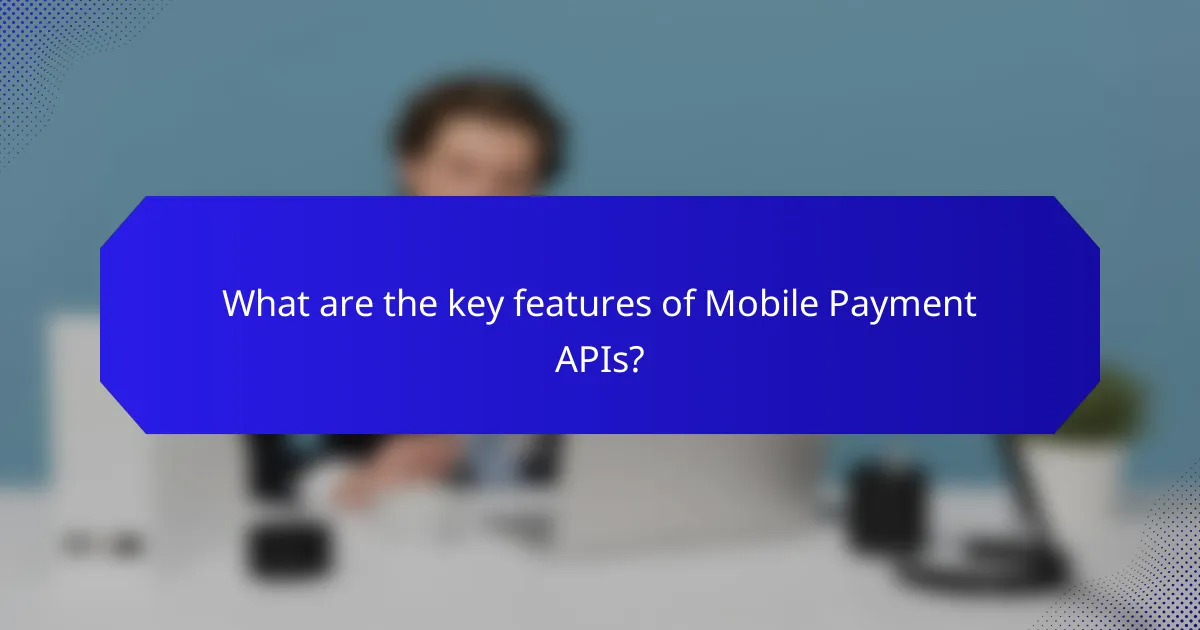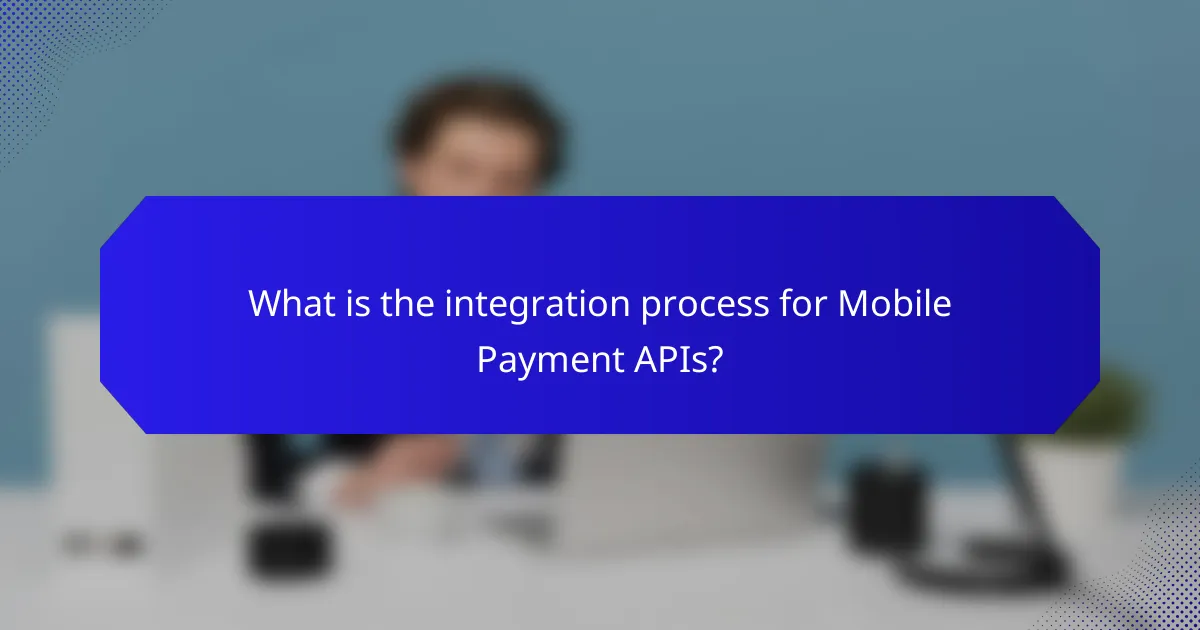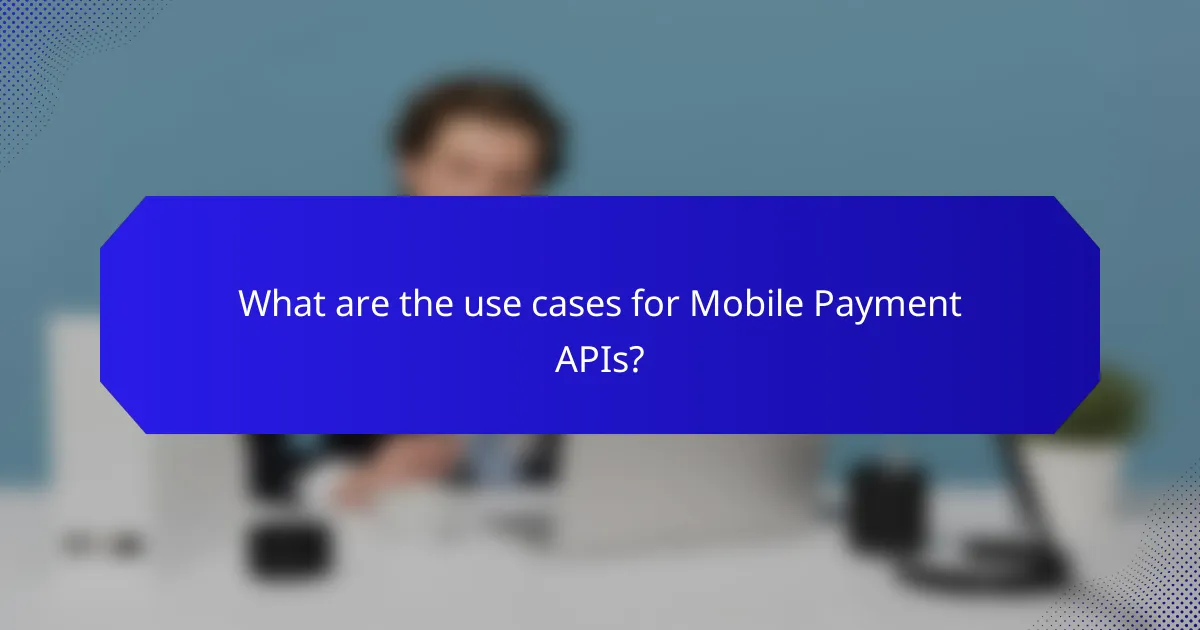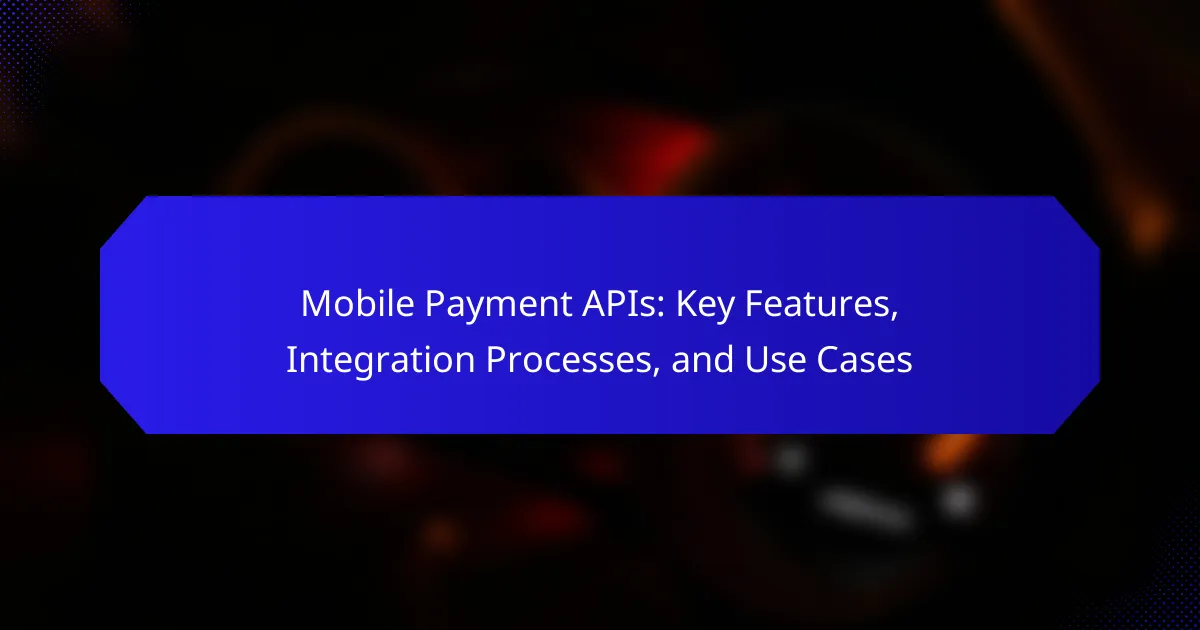Mobile Payment APIs are essential interfaces that enable applications to process payments via mobile devices, supporting various payment methods such as credit cards, digital wallets, and bank transfers. These APIs ensure secure transactions through encryption and compliance with industry standards, enhancing user experience and transaction efficiency. The article outlines the integration process for Mobile Payment APIs, including selecting a payment gateway, obtaining API keys, and configuring settings. Additionally, it explores diverse use cases across sectors, such as e-commerce, peer-to-peer transactions, and point-of-sale systems, highlighting the increasing significance of mobile payments in the financial ecosystem.

What are Mobile Payment APIs?
Mobile Payment APIs are interfaces that allow applications to process payments through mobile devices. They enable developers to integrate payment functionalities into their apps easily. These APIs support various payment methods, including credit cards, digital wallets, and bank transfers. Mobile Payment APIs also ensure secure transactions through encryption and compliance with industry standards. For example, services like PayPal and Stripe provide robust mobile payment APIs. These APIs streamline the payment process, enhancing user experience and increasing transaction efficiency.
How do Mobile Payment APIs function in digital transactions?
Mobile Payment APIs enable digital transactions by facilitating communication between payment systems and applications. They allow developers to integrate payment processing capabilities into their apps seamlessly. When a user initiates a payment, the API securely transmits transaction data to the payment processor. The processor then verifies the transaction with the bank or card issuer. Once approved, the API communicates the confirmation back to the application. This process typically occurs within seconds, ensuring a smooth user experience. APIs also handle various payment methods, including credit cards, digital wallets, and bank transfers. According to a report by Statista, mobile payment transaction volume is expected to surpass $12 trillion by 2024, highlighting the growing importance of these APIs in digital commerce.
What key components are involved in Mobile Payment APIs?
Key components involved in Mobile Payment APIs include authentication, payment processing, and security protocols. Authentication verifies user identity through methods such as tokens or biometric data. Payment processing handles transaction execution and communication with financial institutions. Security protocols ensure data protection during transactions, often employing encryption and compliance with standards like PCI DSS. These components work together to facilitate seamless and secure mobile transactions, enhancing user experience and trust in mobile payment systems.
How do security measures work within Mobile Payment APIs?
Security measures within Mobile Payment APIs protect sensitive financial information during transactions. They utilize encryption to secure data transmission. This means that any information sent between devices is converted into a code that is unreadable to unauthorized parties. Additionally, Mobile Payment APIs implement tokenization. This replaces sensitive card details with unique identifiers or tokens, reducing the risk of data theft.
Authentication methods, such as two-factor authentication, ensure that only authorized users can access payment systems. This adds an extra layer of security by requiring a second form of verification. Regular security audits and compliance with standards like PCI DSS help maintain a secure environment. These practices are crucial for preventing fraud and ensuring user trust in mobile payment solutions.
What advantages do Mobile Payment APIs provide to businesses?
Mobile Payment APIs provide businesses with seamless transaction processing. They enhance customer experience by enabling quick and easy payments. This convenience can lead to increased sales and customer loyalty. Mobile Payment APIs also support multiple payment methods, catering to diverse customer preferences. They improve security through encryption and tokenization, reducing fraud risks. Integration with existing systems is often straightforward, minimizing operational disruptions. Additionally, businesses can access valuable transaction data for better decision-making. Overall, Mobile Payment APIs streamline payment processes and foster a competitive edge.
How do Mobile Payment APIs enhance customer experience?
Mobile Payment APIs enhance customer experience by streamlining transaction processes. They enable quick and secure payments through mobile devices. This convenience reduces wait times at checkout. Customers can make purchases with just a few taps, improving overall satisfaction. Mobile Payment APIs also support various payment methods, including credit cards and digital wallets. According to a study by Statista, mobile payment transactions are projected to reach $12 trillion by 2024, indicating growing consumer preference. Enhanced security features, like tokenization, build trust among users. Additionally, APIs allow for personalized offers and loyalty rewards, further engaging customers.
What cost savings can businesses expect from using Mobile Payment APIs?
Businesses can expect significant cost savings from using Mobile Payment APIs. These savings primarily stem from reduced transaction fees compared to traditional payment methods. Many Mobile Payment APIs offer lower processing fees, which can save businesses up to 2-3% per transaction.
Additionally, Mobile Payment APIs streamline payment processing, reducing the need for physical infrastructure. This can lead to savings in hardware costs and maintenance. Integration with existing systems can also lower operational costs by automating payment workflows.
Moreover, faster transaction times can improve cash flow and reduce the costs associated with delayed payments. According to a report by the Federal Reserve, electronic payments, including mobile payments, are generally cheaper than checks, which incur higher processing costs.
In summary, businesses can achieve cost savings through lower transaction fees, reduced infrastructure needs, and improved cash flow when using Mobile Payment APIs.

What are the key features of Mobile Payment APIs?
Mobile Payment APIs enable secure transactions through mobile devices. Key features include security protocols like encryption and tokenization. These features protect sensitive data during transactions. APIs also support various payment methods, including credit cards and digital wallets. They provide user authentication mechanisms to verify identities. Additionally, Mobile Payment APIs facilitate real-time transaction processing. They offer integration capabilities with e-commerce platforms and point-of-sale systems. Comprehensive documentation and developer support are also essential features for ease of implementation.
Which payment methods are supported by Mobile Payment APIs?
Mobile Payment APIs support various payment methods including credit cards, debit cards, digital wallets, and bank transfers. Credit cards are widely accepted and enable secure transactions. Debit cards facilitate direct withdrawals from bank accounts. Digital wallets like PayPal and Apple Pay provide convenience and speed. Bank transfers allow direct payments from one account to another. These methods enhance user experience and offer flexibility in payment options.
How do Mobile Payment APIs handle different currencies?
Mobile Payment APIs facilitate transactions in multiple currencies by integrating currency conversion features. These APIs typically connect with currency exchange services to provide real-time exchange rates. This ensures accurate conversion at the point of sale. Many APIs support automatic currency selection based on user location or preferences. They also allow merchants to set default currencies for transactions. Security protocols protect sensitive currency data during transactions. Compliance with international financial regulations is essential for these APIs. This ensures smooth handling of cross-border payments. Major providers like PayPal and Stripe offer robust multi-currency support.
What role do user authentication methods play in Mobile Payment APIs?
User authentication methods are critical in Mobile Payment APIs for ensuring secure transactions. They verify the identity of users before granting access to payment functionalities. This process helps prevent fraud and unauthorized access. Various authentication methods include passwords, biometric scans, and two-factor authentication. Each method adds a layer of security to the payment process. For instance, biometric authentication, like fingerprint scanning, is both secure and user-friendly. According to a study by Juniper Research, mobile payment fraud losses are expected to exceed $25 billion by 2024, highlighting the need for robust authentication. Therefore, effective user authentication methods are essential for maintaining trust and safety in mobile payment systems.
How do Mobile Payment APIs ensure security and compliance?
Mobile Payment APIs ensure security and compliance through various mechanisms. They utilize encryption to protect sensitive data during transmission. This prevents unauthorized access and data breaches. Additionally, they comply with industry standards such as PCI DSS. Compliance with these standards mandates secure handling of cardholder information. Mobile Payment APIs also implement tokenization, replacing sensitive data with unique identifiers. This reduces the risk of data exposure. Regular security audits and updates further enhance their security posture. These practices collectively ensure that Mobile Payment APIs maintain high security and compliance levels.
What encryption standards are commonly used in Mobile Payment APIs?
Common encryption standards used in Mobile Payment APIs include AES, RSA, and TLS. AES (Advanced Encryption Standard) is widely adopted for its security and efficiency in encrypting sensitive data. RSA (Rivest-Shamir-Adleman) is commonly used for secure key exchange and digital signatures. TLS (Transport Layer Security) ensures secure communication over networks, protecting data in transit. These standards are essential for safeguarding user information and transaction details in mobile payments. Their implementation is crucial for maintaining trust and security in financial transactions.
How do Mobile Payment APIs comply with regulations like PCI DSS?
Mobile Payment APIs comply with regulations like PCI DSS by implementing strict security measures. They utilize encryption to protect cardholder data during transmission. Access controls limit who can view sensitive information. Regular security assessments are conducted to identify vulnerabilities. Compliance with PCI DSS requires maintaining secure systems and networks. APIs must also ensure that data storage is secure and minimize data retention. Staff training on security protocols is essential for compliance. These measures collectively safeguard against data breaches and fraud.

What is the integration process for Mobile Payment APIs?
The integration process for Mobile Payment APIs involves several key steps. First, developers must select a suitable payment gateway that offers a Mobile Payment API. Next, they need to create an account with the chosen payment provider. This account typically requires verification and setup of merchant details.
After account creation, developers must obtain API keys from the payment provider. These keys authenticate requests made to the API. Following this, they integrate the API into their mobile application. This integration usually involves adding SDKs or libraries provided by the payment gateway.
Developers then configure the API settings according to their application’s needs. This includes setting up payment methods, currencies, and transaction types. Testing is a critical step, ensuring that transactions process correctly in a sandbox environment before going live.
Finally, developers deploy the application and monitor transactions to ensure smooth operations. Successful integration allows for secure and efficient mobile payments, enhancing user experience.
What steps are involved in integrating Mobile Payment APIs into a platform?
Integrating Mobile Payment APIs into a platform involves several key steps. First, select a suitable mobile payment API provider based on your platform’s needs. Popular options include Stripe, PayPal, and Square. Next, create an account with the chosen provider to obtain API keys. These keys are essential for authentication during transactions.
Then, review the API documentation provided by the provider. This documentation outlines integration methods, endpoints, and data formats. After familiarizing yourself with the documentation, implement the API into your platform’s codebase. This often involves setting up SDKs or libraries specific to your development environment.
Once the integration is coded, conduct thorough testing in a sandbox environment. This ensures that transactions can be processed without errors. Finally, deploy the integration to your live platform and monitor transactions for any issues. Following these steps ensures a smooth integration of mobile payment APIs.
What tools and resources are necessary for integration?
Integration of mobile payment APIs requires specific tools and resources. Essential tools include software development kits (SDKs) provided by payment processors. These SDKs facilitate the integration of payment functionalities into applications. Additionally, application programming interfaces (APIs) are crucial for enabling communication between different software systems.
Resources such as documentation and support from payment providers are necessary for successful integration. Testing environments are also important to ensure the functionality of the integration before going live. Furthermore, security tools are essential to safeguard sensitive payment information during transactions.
These components collectively streamline the integration process and enhance the reliability of mobile payment systems.
How can developers test Mobile Payment API integrations effectively?
Developers can test Mobile Payment API integrations effectively by using a combination of sandbox environments, automated testing, and real transaction simulations. Sandbox environments allow developers to simulate transactions without involving real money. This approach helps identify issues early in the development process. Automated testing frameworks can streamline the testing process, ensuring that all API endpoints are functioning as expected. Real transaction simulations should be conducted in a controlled manner to validate the API’s behavior under actual conditions. According to industry standards, thorough testing can reduce payment processing errors by up to 30%.
What challenges might arise during the integration of Mobile Payment APIs?
Challenges during the integration of Mobile Payment APIs include technical compatibility issues. Different platforms may utilize varying standards and protocols. This can lead to difficulties in ensuring seamless communication between systems. Security concerns are also prevalent. Mobile payment systems must comply with stringent regulations to protect user data. Additionally, developers may face challenges related to user experience. Integrating payment solutions should not disrupt the overall app functionality. Testing and debugging can be complex and time-consuming. Ensuring all transactions are processed accurately is critical. Lastly, ongoing maintenance and updates can pose logistical challenges. These factors can significantly impact the integration timeline and overall success.
How can businesses overcome common integration obstacles?
Businesses can overcome common integration obstacles by implementing a structured integration strategy. This includes conducting thorough needs assessments to identify specific requirements. Establishing clear communication channels among stakeholders is essential. Utilizing standardized protocols and APIs can streamline the integration process. Regular testing during integration phases helps identify issues early. Providing adequate training for staff ensures smooth adoption of new systems. Additionally, leveraging expert consultation can guide businesses through complex integration challenges. According to a 2022 report by McKinsey, companies that adopt these practices see a 30% increase in integration efficiency.
What best practices should be followed during the integration process?
Best practices during the integration process of mobile payment APIs include thorough planning and clear documentation. Establish a detailed project timeline to manage expectations. Ensure that all stakeholders are involved in the planning phase. Conduct API compatibility checks to confirm system requirements. Implement robust security measures to protect user data. Test the integration in a controlled environment before going live. Monitor performance metrics post-integration to identify issues. Regular updates and maintenance are essential for long-term success. These practices enhance efficiency and security, leading to a smoother integration experience.

What are the use cases for Mobile Payment APIs?
Mobile Payment APIs enable various use cases across different sectors. They facilitate in-app purchases for e-commerce platforms, allowing users to buy products seamlessly. Mobile Payment APIs support peer-to-peer transactions, enabling users to send money to friends or family easily. They are also used in subscription services, automating recurring payments for users.
Additionally, businesses utilize these APIs for point-of-sale transactions, enhancing the checkout process. Mobile Payment APIs are integrated into loyalty programs, allowing customers to earn and redeem rewards effortlessly. They also support international transactions, enabling cross-border payments with minimal friction.
According to Statista, mobile payment transaction value is expected to reach over $12 trillion by 2024, highlighting their growing significance in the financial ecosystem.
How are Mobile Payment APIs utilized in e-commerce platforms?
Mobile Payment APIs are utilized in e-commerce platforms to facilitate secure transactions. They enable users to make payments via their mobile devices seamlessly. These APIs integrate with various payment gateways to process credit and debit card transactions. They also support digital wallets, allowing customers to pay using stored payment information. Mobile Payment APIs enhance user experience by offering quick checkout options. They often include features like tokenization for added security. According to a report by Statista, mobile payments are projected to reach $12 trillion by 2025. This growth demonstrates the increasing reliance on Mobile Payment APIs in e-commerce.
What specific features enhance transactions in e-commerce through Mobile Payment APIs?
Mobile Payment APIs enhance e-commerce transactions through features like secure authentication, real-time processing, and multi-currency support. Secure authentication ensures that user data is protected, reducing fraud risk. Real-time processing allows for instant transaction confirmations, improving customer experience. Multi-currency support enables transactions in various currencies, catering to a global audience. Additionally, integration with digital wallets streamlines the payment process. Analytics and reporting features provide valuable insights into transaction trends. These features collectively contribute to a more efficient and user-friendly e-commerce environment.
How do Mobile Payment APIs support subscription services?
Mobile Payment APIs support subscription services by enabling automated billing and payment processing. They facilitate recurring transactions without manual intervention. This automation ensures timely payments from customers, reducing the risk of missed payments. APIs provide secure transaction methods, enhancing customer trust. They also allow for easy integration with existing systems. This integration streamlines the management of subscription plans and customer data. Additionally, Mobile Payment APIs often offer analytics features. These features help businesses track subscription metrics and customer behavior effectively.
What industries are adopting Mobile Payment APIs and why?
Retail, e-commerce, hospitality, and transportation industries are adopting Mobile Payment APIs. Retailers use these APIs to enhance customer experience and streamline transactions. E-commerce platforms leverage Mobile Payment APIs to enable fast and secure online payments. The hospitality industry adopts these APIs to facilitate seamless check-ins and payments at hotels and restaurants. Transportation services, including ride-sharing apps, utilize Mobile Payment APIs for quick fare payments. These industries benefit from increased efficiency, improved customer satisfaction, and reduced transaction times. According to a report by Statista, mobile payment transaction value is expected to reach $12.06 trillion by 2025, highlighting the growing trend across various sectors.
How do Mobile Payment APIs benefit the retail sector?
Mobile Payment APIs benefit the retail sector by streamlining transactions and enhancing customer experience. They facilitate quick and secure payments, reducing checkout times. Retailers can integrate multiple payment options, catering to diverse customer preferences. This flexibility can lead to increased sales and customer satisfaction. According to a study by Statista, 75% of consumers prefer mobile payments for their convenience. Additionally, these APIs often come with advanced security features, minimizing fraud risks. Overall, Mobile Payment APIs help retailers adapt to modern shopping behaviors and improve operational efficiency.
What role do Mobile Payment APIs play in the hospitality industry?
Mobile Payment APIs facilitate seamless transactions in the hospitality industry. They enable hotels and restaurants to accept payments through mobile devices. This enhances customer convenience and speeds up the payment process. Mobile Payment APIs also support various payment methods, including credit cards and digital wallets. They integrate easily with existing point-of-sale systems. This integration allows for real-time transaction processing and improved inventory management. According to a study by Statista, mobile payments in the hospitality sector are projected to reach $1.5 trillion by 2025. This growth highlights the importance of Mobile Payment APIs in enhancing operational efficiency and customer satisfaction.
What are the best practices for using Mobile Payment APIs effectively?
To use Mobile Payment APIs effectively, developers should prioritize security, user experience, and compliance. Implementing strong encryption methods protects sensitive data during transactions. Utilizing tokenization minimizes the exposure of card details. Ensuring a seamless user interface enhances customer satisfaction. Regularly updating APIs keeps them secure and functional. Testing APIs thoroughly before deployment identifies potential issues. Monitoring transaction logs helps detect fraudulent activity. Following industry standards, such as PCI DSS, ensures compliance and builds trust.
Mobile Payment APIs are essential interfaces that enable applications to process payments via mobile devices. This article covers key features of Mobile Payment APIs, including security protocols, supported payment methods, and user authentication. It details the integration process, highlighting necessary tools and best practices to overcome common challenges. Additionally, various use cases across industries, such as retail and e-commerce, are explored, emphasizing the advantages these APIs provide in enhancing transaction efficiency and customer experience.
